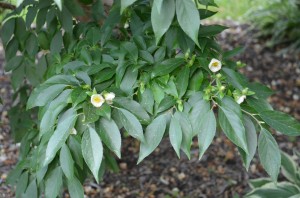Not enough gardeners know about stewartias (Stewartia spp.). Six species are found under cultivation, 2 native to the U.S. and 4 of Asian origin. One of the rarest seen in U.S. gardens is tall stewartia (S. monadelpha) (USDA hardiness zones 5-8). Tall stewartia is a more site forgiving than Japanese stewartia (S. pseudocamellia), the most popular planted in U. S. gardens.
Tall stewartia develops into a 25 to 30 feet high shrub or small tree. The bark on the trunk and adjacent branches gradually ages to a lovely cinnamon tint. Spring/summer foliage is medium green, 3-inches long, and slightly glossy on the surface. Leaves turn red to burgundy red before abcising in late autumn. Numerous small white frilly petalled flowers with gold stamens appear in June. By early fall reddish brown fruits have fully developed and are of little ornamental value.
All stewartias are fussy in one respect. Their roots should be planted in a moderately acidic (pH 5.8 to 6.8), organically rich, and most important, in a well-drained soil. Just a hint of soggy ground might be enough to trigger an outbreak of root rot disease and their demise. Extreme summer drought is also punishing to stewartias. Planting on a slope is often a wise practice.
Tall stewartia exhibits better heat tolerance than other species. It is best protected from direct mid-day sun in zone 7 and further south. Most stewartias are meant to be viewed 12 months a year. Plant them in full morning sunlight nearby a patio or deck, or near a window where it may be viewed from inside your home. Install up-lighting to capture branching silhouette and lovely flaky cinnamon colored bark in the evening hours. Cinnamon bark coloration gets better as the tree ages.
Pests and other diseases are rarely problems except for Japanese beetles, which can skeltonize leaves over 3 to 4 week time span. Numerous pesticides, including short-lived pyrethrins or insecticidal soaps, are effective, but must be reapplied every 3-4 days until the bug onslaught has subsided.


 Posted in
Posted in 
